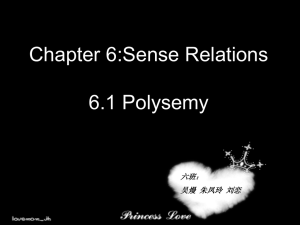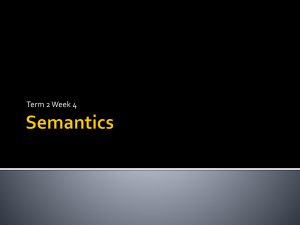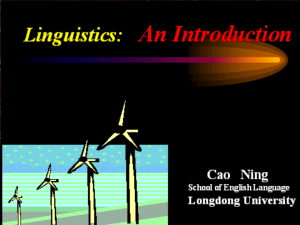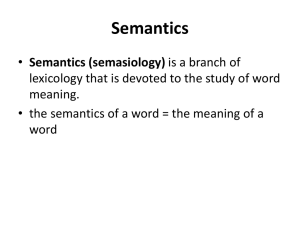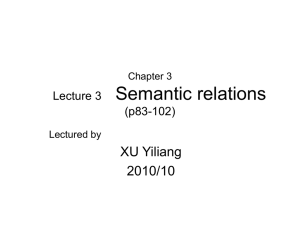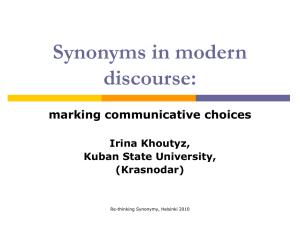Evaluating semantic similarity and sameness in studies of polysemy
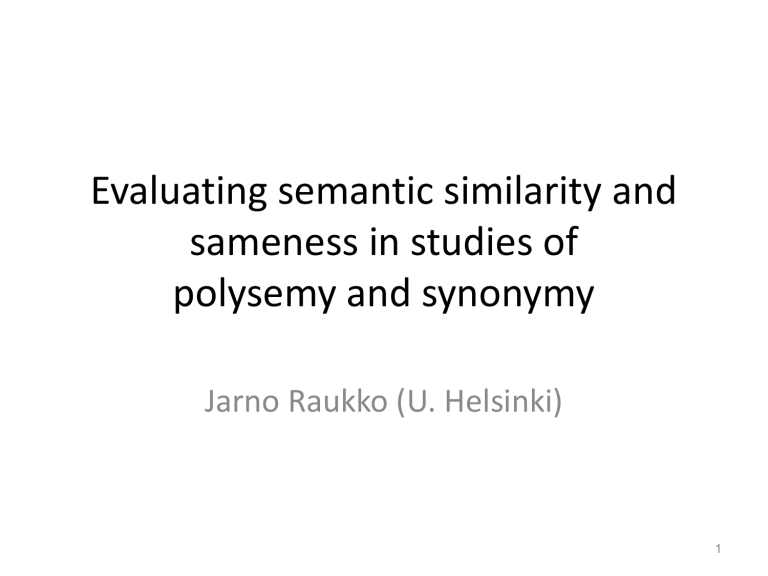
Evaluating semantic similarity and sameness in studies of polysemy and synonymy
Jarno Raukko (U. Helsinki)
1
For a full version of the PPT, see handout distributed Oct 28, 2010.
SKY WEBPAGE VERSION
2
2. Are violin and fiddle synonyms?
EXPECTED ANSWER:
”Well, almost.”
(SYNONYMY)
Examples
1. Are thrifty and stingy synonyms?
EXPECTED ANSWER:
”Well, not quite.”
3. Does back have the same meaning in
My back hurts and
I came back?
EXPECTED ANSWER:
”Not at all. Different.”
4. Does back have the same meaning in
I came back and
I got it back?
EXPECTED ANSWER:
”Well, almost.”
(POLYSEMY)
3
Relevance of semantic similarity
(vs. difference)
• In synonymy: you expect similarity for a pair/(set) of items to be of interest
• In polysemy: primarily, you expect difference for a pair/(set) of items to be of interest;
secondarily, you group items according to similarity and difference
4
Yet…
SYNONYMY
SIMILARITY DIFFERENCE
(DEFAULT)
Synonymy is about similar meanings of different words.
But you are interested in the differences between near-synonyms.
POLYSEMY
Polysemy is about related (and therefore somehow similar) meanings of a word.
(DEFAULT)
Polysemy is about different (related) meanings of a word.
5
synonymy --- polysemy ?
• Dirk Geeraerts tomorrow in Helsinki:
”The problem of synonymy and the problem of polysemy are essentially the same”
• Dylan Glynn & Justyna Robinson (eds, in press)
Polysemy and Synonymy. Corpus methods and
applications in Cognitive Linguistics. Amsterdam:
Benjamins.
6
synonymy
WORD 1 WORD 2
If their semantic content is similar or the same, this is a case of synonymy.
If their semantic content is (very) different, a researcher of synonymy ignores this case.
7
polysemy
MEANING 1
OF WORD 1
MEANING 2
OF WORD 1
The starting point is that Word 1 has at least 2 (different) meanings.
If meanings 1 and 2 are very similar, this might be a case of vagueness.
If meanings 1 and 2 are totally different (and not related semantically), this might be a case of homonymy.
If meanings 1 and 2 are somewhat different but somehow relatable (or a bit similar), this is probably a case of polysemy.
henceforth W = word M = meaning
8
scale of similarity: synonymy
The meaning of W1 and W2 is…
THE SAME --------------------------------- DIFFERENT perfect nearweak synonymy synonymy synonymy full semiquasisynonymy synonymy synonymy
NOT
WORTH
DISCUSSION
9
scale of similarity: polysemy
The meaning of M1 and M2 (of W1) is…
THE SAME --------------------------------- very DIFFERENT two vaguep o l y s e m y instances ness of the same meaning two instances of the same meaning type
(ambiguity) instances of different (yet related) meaning types homonymy
10
Main question
• Is semantic similarity somehow different when we look at polysemy than we look at synonymy?
11
Differences so far
• Which is the default, similarity or difference?
• In synonymy, we idealize on the extreme of the scale, but mainly look at the part of the scale which is (fairly) close to the extreme.
• In polysemy, we operate pretty much on the whole scale, with focus on the middle.
12
synonymy --- polysemy ?
• when you study synonymy, the polysemy of the items gets in the way
– can you ever say “W1 and W2 are synonymous”?
– should you always say “M x synonymous?
of W1 and M y of W2” are
• when you study polysemy, you often use synonyms to talk about meanings
– “Are get ‘receive’ and get ‘arrive’ meanings of the same verb?”
13
synonymy --- polysemy ?
• Synonymy occurs when meaning is shared (but form differs)
• Polysemy occurs when form is shared (but meaning differs)
• Synonymy is a relational lexical-semantic property that unites
(parts of the semantic potential of) “accidentally” coinciding words
– The forms of words involved in the synonymy relationship are arbitrary (although the relationships might be nonarbitrary, cf. Levin this morning)
– The semantic value (that is shared) is motivating enough that two or more forms coincide on it
– It is typical that one meaning can be expressed with two different words.
14
synonymy --- polysemy ?
• Polysemy is a semantic property of one word at a time that unites meanings. The relationship between them is motivated, but it is only sometimes predictable.
– It is not accidental or arbitrary that words acquire polysemy. It is in their nature. :-)
– It is typical for semantic value to be flexible, extended, and
“multiplied”.
– Polysemy is about categorization, both between words (W1 covers a semantic territory) and within a word (M1 and M2 are categories too).
• One form : One meaning
• a principle that cognition may strive for / take as a default
• synonymy breaks it
• polysemy breaks it
15
synonymy --- polysemy ?
• The role of co(n)text
• You can evaluate synonymy in identical co(n)texts:
I like to play the fiddle in bars.
I like to play the violin in bars.
• Usually you evaluate polysemy in non-identical co(n)texts
I got to Zabriskie Point.
I got to a point in my life where…
• But you can use identical co(n)texts as well.
I got to be the last one.
I got to be the last one.
16
evaluating
• To study shades of semantic similarity, we need to evaluate it.
• A corpus cannot tell us if two instances are semantically similar
– It requires human judgement
• The main use of evaluating in this paper:
– How informants / test subjects / speakers evaluate the semantic similarity (or difference) of linguistic items in a more or less experimental setting
(e.g., similarity rating test)
≈ Data elicitation ≈ Population test
17
evaluating
• quantitative:
– Estimate the degree of synonymy
(or semantic distance between two meanings in polysemy)
• qualitative:
– Justify / explain / explicate the nature of / the reason for semantic similarity
18
evaluating takes place in real life as well
• synonymy (examples)
– in linguistic production, you e.g. estimate which of the near-synonyms might suit your needs best
– in comprehension, you e.g. estimate whether near-synonyms that you have encountered refer to the same semantic value
– in communication, when you negotiate meaning, you e.g. operate with synonymous alternatives
• polysemy (examples)
– in production, you e.g. apply words to new contexts
– in comprehension, you e.g. approximate meanings according to related meanings of the same word
– jokes often exploit polysemy
– polysemy may cause misunderstandings
– in communication, when you negotiate meaning, you e.g. cross-check with polysemy of other words
19
(Back to experiments/elicitation.)
Expected difference between synonymy and polysemy, 1
• If an informant is asked to rate the semantic similarity/difference of two words,
– the very fact that they are different words might cause her/him to presuppose that there is at least some semantic difference.
– Therefore, rating two words ”semantically identical” requires a marked choice.
– However, if the informant realizes that the researcher is after synonymy, then evaluating W1 and W2 as semantically similar is more likely.
20
Expected difference between synonymy and polysemy, 2
• If an informant is asked to rate the semantic similarity/difference of two meanings of one word,
– the very fact that they are uses/instances of the same word might cause her/him to presuppose that there is at least some semantic similarity.
– Therefore, rating two words ”semantically totally/very different” requires a marked choice.
– However, if the informant realizes that the researcher is after polysemy, then evaluating M1 and M2 as semantically different is more likely.
21
Factors that influence
• In both cases (synonymy and polysemy)
– it matters a great deal
• Which test (type) we use
• What the instructions (exact phrasings) are
• Whether there is an example rating given by the researcher
• What the selection of stimuli is
• What the linguistic context of each stimulus is
• Which types of cases have been placed in the
beginning of the test (or, the order in general)
22
Factors that influence
• Should we expect (total) consensus?
• No. There will be subjective differences.
• Why?
• The nature of semantics:
• Based on intersubjective convention
• Based on negotiation and flexibility
• Must allow for variability and variation
23
Examples from (more or less) experimental studies on synonymy and polysemy
24
Whitten & al. 1979 (synonymy)
• “Indicate the degree to which two words have the same meaning by writing a digit from 1 to 7.”
• 7 =excellent synonymy
• 1 = poor synonymy
• All 464 stimulus noun pairs were listed as synonyms in standard references.
• The rated degree of synonymy ranged from 6.79 to
2.24. The median was 5.08.
• If placed within context of nonsynonym pairs, the ratings for the low end might have been higher.
25
Whitten & al. 1979 (synonymy) cont’d
• Stimulus pairs at the high end:
• purchase – buy
• lawyer – attorney
6.79
6.78
•
• autumn – fall penny – cent
6.72
6.71
• taxi – cab 6.71
• Stimulus pairs close to the median
• college – university 5.12
• output – yield 5.10
• expert – authority 5.09
• effort – attempt
• servant – maid
• soldier – warrior
5.08
5.08
5.07
26
Whitten & al. 1979 (synonymy) cont’d
• Stimulus pairs at the low end:
• thunder – clap
• patient – invalid
• needle – spike
2.72
2.55
• visit – chat 2.52
• suburb – neighborhood 2.34
2.24
• Although instructions said that all stimuli are nouns, some of these are more common as verbs: buy, purchase, visit, chat
• The polysemy is obvious in many cases: fall, authority, clap, patient, invalid
27
Whitten & al. 1979 (synonymy) cont’d
• The main variable that they paid attention to was the order of the two stimuli: ½ of the informants got “forward order”, ½ got
“back order”.
– In 1979 one of their main aims was to study the structurings of the mental lexicon and lexical access.
– Example: purchase => buy 6.72
buy => purchase 6.86
– On average, perceived synonymy was affected by word order.
– For 21 word pairs, the effect of the order was significant.
28
Whitten & al. 1979 (synonymy) cont’d
• Some of the 21 word pairs where the order played a significant role in the rating of the degree of synonymy: motive => reason quarter => fourth mission => task era => age appetite => hunger nectar => honey aborigine => native
6.28
6.24
5.66
5.80
5.18
4.94
4.52
reason => motive fourth => quarter task => mission age => era
5.56
5.00
4.84
4.60
hunger => appetite honey => nectar
4.24
3.68
native => aborigine 3.22
• Generalization: a more specific, more academic, and less polysemous word prompts a positive synonymy judgement more readily than vice versa.
29
Whitten & al. 1979 (synonymy) cont’d
• Variance (between informants)
– Mostly .50–1.20 at the end of 50 most synonymous
• Exceptionally high variance at the high synonymy end:
– murder => homicide 2.75 (cf. homicide => murder
1.03)
– Mostly 2.00–3.00 at the median of the scale
• Exceptionally low variance: province => territory 1.55
• Exceptionally high variance: congress => legislature 3.79
– Mostly 2.50–4.00 at the end of 50 least synonymous
• That is, there was little consensus at the lower end of the scale.
30
Raukko 1994 (polysemy)
• “Decide whether the word get carries the same meaning or two different meanings in the sentences.”
– 0 = the same meaning
– 2 = somewhat different meaning
– 4 = very different meaning
(heuristic post hoc: 4 might mean homonymy; 0 would refer to two instances of the same meaning type; typical polysemy would be 1...3)
31
Raukko 1994 (polysemy)(cont’d)
• Data from my 1994 test, see handout.
32
Comparisons so far
• Whitten & al. / synonymy
– scale 1...7 (1 = very different meaning, 7 = same meaning)
– synonymy ratings ranged 2.24...6.79
– median 5.08 (most pairs were viewed at least somewhat synonymous)
• Raukko / polysemy
– scale 0...4 (0 = same meaning, 4 = very different meaning)
– polysemy ratings ranged 0.45...3.13
– average rating 1.55, median 1.34 (most pairs were viewed as having fairly similar but not identical meaning)
33
Comparisons so far
• Whitten & al. / synonymy
– informants saw synonymy where they were supposed to
• Raukko / polysemy
– informants did not see large meaning difference for the most part => get is polysemous, not homonymous
– they saw some similarities, some differences, as predicted
=> they saw polysemy
• both
– differing degrees of similarity were apparent
– many ratings make sense, some don’t
– method is useful but there are skewing effects and irreliability in several details of the setting
34
Conclusions so far
• In both synonymy and polysemy studies, semantic intuitions vary.
• In both synonymy and polysemy studies, finding a scale of semantic similarity is useful.
– Cf. Sandra & Rice 1995: 125
• “[researchers of prepositional polysemy] cannot propose extremely fine-grained distinctions without bothering about empirical data”
• “language users’ mental representation [...] is [in fact] characterized by a high degree of granularity”
35
quantitative => qualitative
• Whitten & al’s and Raukko’s similarity rating tests did not include informants justifying and explaining their ratings.
• E.g., Liu (this symposium) reports tests with informants explaining their choices.
• In Raukko’s study, qualitative results come from other types of tests
– sorting test: (1) combine stimuli into categories, (2) give names to categories, etc.
– production test: (1) produce examples of the use of polysemy, (2) explain links you find between them, etc.
• Vanhatalo 2005
36
Vanhatalo 2005 (synonymy)
• her PhD, The use of questionnaires in exploring synonymy
• several types of tests
– choose most likely components
– rate components
– choose better alternative (cf. Liu)
– complete as sentences (only the word given)
– define typical frames
– spell out semantic differences
37
Vanhatalo 2005 (cont’d)
• several factors investigated
– 18 Finnish verbs of “nagging”, 17 Estonian verbs of nagging
• the gender and age of the portrayed speaker (the subject of “nag”)
• the degree of irritation of the portrayed speaker and hearer
• the volume of the vocal act
– 2-4 Finnish adjectives ‘important, central, crucial, significant’: open questions mainly
38
Vanhatalo 2005 (cont’d)
• main results (Vanhatalo 2005: 40-45): the questionnaire method
– helped to trace differences in the meaning and use of synonyms
• many differences not documented before in dictionaries
• sometimes consensus, sometimes deviation
• useful especially for large groups of semantically similar words
• (Vanhatalo did not use the method for placing synonyms on a scale of similarity)
• both open questions and ratings should be used
39
Vanhatalo 2005 (cont’d)
• main results (Vanhatalo) (cont’d)
– helped to find differences between related words in
Estonian and Finnish
– sociodemographic variables caused fairly little variation
• age and education affected a bit more than gender
• answers critique
40
Vanhatalo 2005 (cont’d)
• main results (Vanhatalo) (cont’d)
– when both corpus method and questionnaire method were applicable, they yielded similar results
• however, justification of results was different
• questionnaire method dug up semantic properties that corpus method could not
• in addition, can tackle low-frequency words
– results of questionnaire method can be utilized in the production of electronic dictionaries
41
Other studies of synonymy that employ experimental techniques
• Arppe & Järvikivi 2002, 2007
• Divjak & Gries 2008
• Liu, in this symposium
• Oversteegen, in this symposium
• etc.
42
polysemy / qualitative
• In experimental settings (e.g., the sorting test) :
– An informant gives a name to a meaning type, a category within polysemy
– An informant spells out the semantic link between two meanings
– An informant draws a hierarchy between macrotypes and microtypes (more general and more specific meaning types)
– An informant pinpoints at cases difficult to evaluate
43
• to conclude…
And…
44
Evaluating semantic similarity
• Both synonymy and polysemy operate on the scale of semantic similarity vs. difference.
• Knowing about the degree of similarity is one useful property of both.
• The way to find out about it is to use elicitation/experiments.
• There is deviation in informants’ ratings.
• A simple explanation: informants use different criteria for evaluation.
• Solutions: let them explicate the criteria.
use multiple methods.
45
Synonymy vs. polysemy
• Evaluating semantic similarity between the meanings of two separate words (synonymy) is a matter of evaluating the match between two separate ”semantic events”
– There should be mismatch, but there isn’t.
• Evaluating semantic similarity/relatedness/ difference between the meanings of one word
(polysemy) is a matter of comparing the applications of one single category.
– There should be match between the semantic events.
46
Synonymy vs. polysemy
• When you evaluate near-synonyms, you balance between (i) the ideal of what would constitute a perfect match and (ii) the nuances of the near-synonyms
• When you evaluate meanings of a polysemous word, you balance between (i) the assumption that some meaning should be shared and (ii) the actual semantic profile of the uses
47
Synonymy vs. polysemy
• In evaluating synonymy, the idealized equivalence can be taken from the semantic description of either of the two words.
• In evaluating polysemy, the common factor
(”core meaning”, ”shared meaning”) may be hard to find, or become too abstract.
Maybe the first task is easier?
48
General relevance
• ”Insights in the equality or similarity of meaning may shed light on meaning itself”
(Oversteegen / SKY 2010, Helsinki)
• The question of “identical meaning” is a crucial basis for e.g. typology and language comparisons: the problem of tertium comparationis
– Cf. Haspelmath’s plenary on Saturday
49
References
Arppe, Antti & Juhani Järvikivi 2007.
Every method counts –
Combining corpus-based and experimental evidence in the study of synonymy. Corpus
Lingustics and Linguistic Theory 3:
2: 131-159.
Colombo, Lucia & Giovanni B. Flores d’Arcais 1984. The meaning of
Dutch prepositions: a psycholinguistic study of polysemy. Linguistics 22: 51-98.
Divjak, Dagmar & Stefan Gries 2008:
Clusters in the mind? Converging evidence from near-synonymy in
Russian. The Mental Lexicon 3: 2:
188-213.
Geeraerts, Dirk – in this symposium
Liu, Dilin – in this symposium
Oversteegen, Eleonore – in this symposium
Raukko, Jarno 2003. Polysemy as flexible meaning: experiments with
English get and Finnish pitää. In
Brigitte Nerlich & al (eds) Polysemy.
Flexible patterns of meaning in
mind and language. 161-193.
CONTINUED...
50
References Author’s cont’d contact information
Sandra, Dominiek & Sally Rice 1995.
Network analyses of prepositional meaning: mirroring whose mind – the linguist’s or the language user’s?
Cognitive Linguistics 6: 89-130.
Vanhatalo, Ulla 2005. Kyselytestit
synonymian selvittämisessä (etc.) [The use of questionnaires in exploring synonymy, etc.] PhD thesis, U-Helsinki. http:/ethesis.helsinki.fi/julkaisut/hum/ suoma/vk/vanhatalo/kyselyte.pdf
Whitten, William B. II, W: Newton Suter, and Michael L. Frank 1979.
Bidirectional Synonym Ratings of 464
Noun Pairs. Journal of Verbal Learning
and Verbal Behavior 18: 109-127.
• e-mail:
See handout and list of participants.
• home postal address
See handout.
• affiliation
Department of Modern
Languages
Metsätalo (Unioninkatu 40 B)
FIN-00014 University of Helsinki
Finland
51
